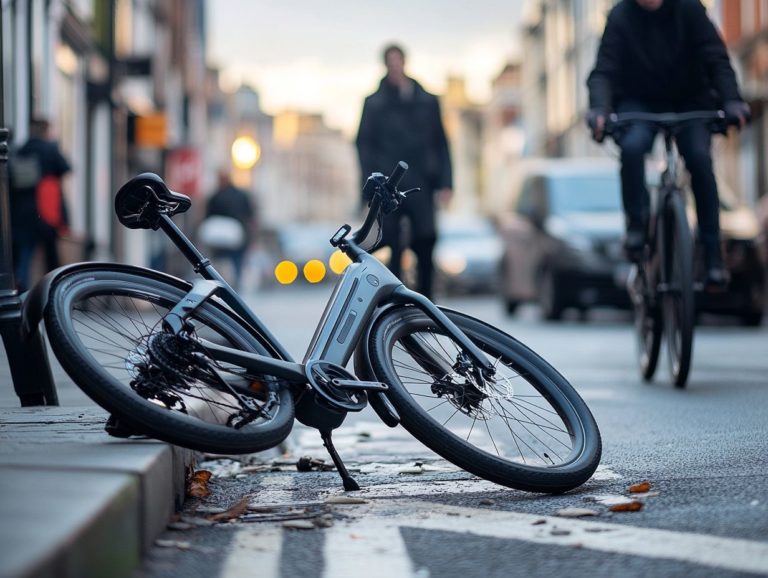Can You Ride Electric Bicycles at Night? Laws Explained
Electric bicycles, or electric bicycles, are revolutionizing your commute, providing a sustainable alternative that packs a bit of extra power. In the evolving legal landscape, riding an electric bicycle has become increasingly popular among urban dwellers.
But what unfolds when the sun dips below the horizon? Riding an electric bicycle at night can be thrilling and fun! It also introduces a unique set of rules, safety considerations, and benefits that you should be aware of.
This article delves into the various types of electric bicycles, the regulations surrounding nighttime riding, essential safety tips, and the perks of cruising after dark. Additionally, you’ll find insights into alternative transportation options to consider when evening arrives.
Whether you re a seasoned rider or simply intrigued, there s a wealth of information waiting for you in the realm of nighttime e-biking.
Contents
- Key Takeaways:
- Overview of Electric Bicycles
- Rules and Regulations for Riding Electric Bicycles at Night
- Safety Tips for Riding Electric Bicycles at Night
- Benefits of Riding Electric Bicycles at Night
- Alternatives to Riding Electric Bicycles at Night
- Frequently Asked Questions
- Can you legally ride electric bicycles at night?
- What are the laws regarding riding electric bicycles at night?
- Do I need any additional equipment to ride my electric bicycle at night?
- Are there speed restrictions for riding electric bicycles at night?
- Can I get a DUI while riding an electric bicycle at night?
- Are there any safety tips for riding an electric bicycle at night?
Key Takeaways:
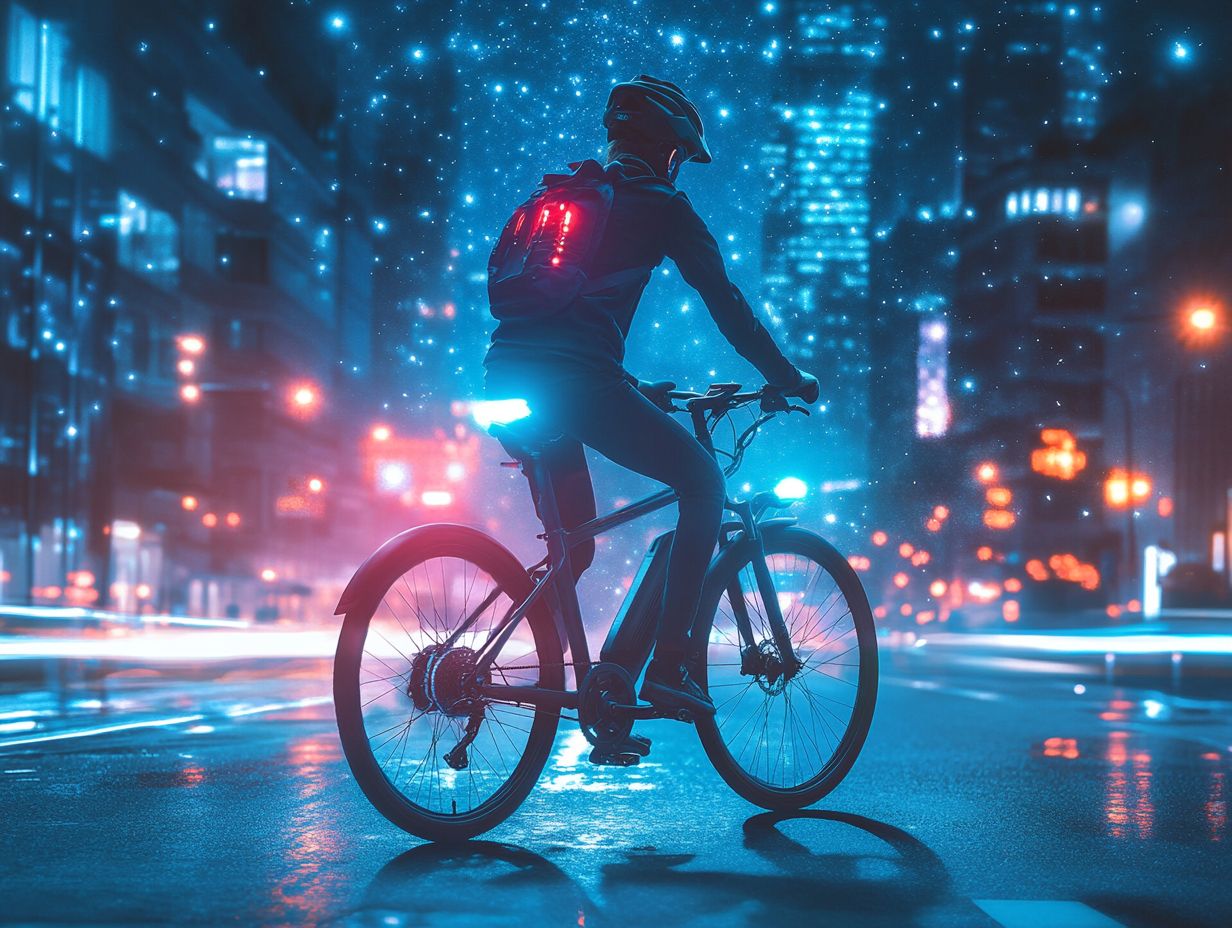
- You can ride electric bicycles at night, but remember to follow local laws and take safety precautions.
- Equip your electric bicycle with lights and reflectors for better visibility.
- Riding at night can save you time and money, but consider other transport options for your safety.
Overview of Electric Bicycles
Electric bicycles, or e-bikes, are a remarkable advancement in personal transportation. They seamlessly combine the essence of traditional cycling with the convenience of modern electric assistance.
You ll encounter various classifications Class 1, Class 2, and Class 3. Each class is defined by its distinct levels of help while pedaling and help with a button.
It’s crucial for you to grasp the differences among these classes, especially given the diverse legal frameworks that govern their use in states like California and New York City.
When selecting your electric bicycle, consider the safety standards established by organizations such as the Consumer Product Safety Commission (CPSC) and any local regulations, including laws for electric bicycles, that could impact your riding experience.
Definition and Types of Electric Bicycles
Electric bicycles are essentially bicycles enhanced with an electric motor that assists you while riding. This makes cycling a delightful option for individuals of all ages and abilities. There are three primary classes to consider: Class 1, which offers help while pedaling; Class 2, which provides help with a button; and Class 3, which combines both features, often seen in electric mountain bikes designed for rugged terrains.
Each class boasts unique characteristics tailored to varying preferences and riding conditions. For instance, the pedal assist in Class 1 amplifies the natural cycling experience, making it perfect for commuters who want exercise without overexertion. Models like the Specialized Turbo Vado have gained popularity among those seeking this balance.
On the other hand, Class 2’s help with a button offers a laid-back riding experience, ideal for leisure and casual exploration brands like Rad Power Bikes embody this spirit perfectly.
Class 3 bikes take the best of both worlds, delivering versatility and speed, making them well-suited for adventurous trails or long-distance rides. By grasping the distinctions between these assist modes, you can enhance your riding experience and maximize efficiency across diverse terrains.
Rules and Regulations for Riding Electric Bicycles at Night
Riding electric bicycles at night demands your attention to a range of rules and regulations, not just for compliance with road laws but for your own safety as well.
Each state boasts its own unique set of laws governing e-bike use after dark, including helmet requirements, registration mandates, and age restrictions that can vary dramatically from California to Florida. Familiarizing yourself with local regulations will help you navigate the night with both safety and legality in mind.
Ready to take on the night? Grab your electric bicycle and experience the thrill for yourself!
State and Local Laws
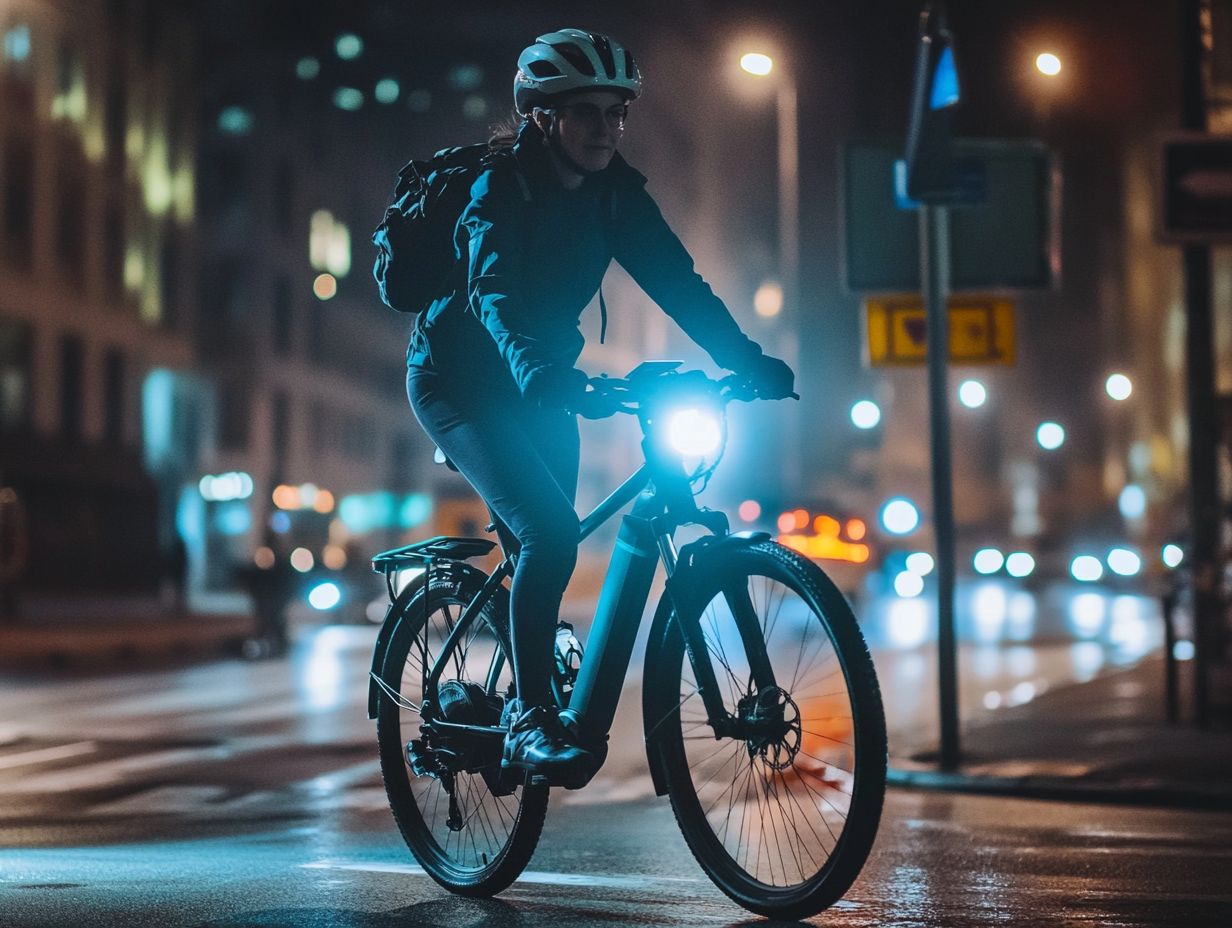
State and local laws significantly shape the legal framework surrounding electric bike usage, with regulations varying considerably from one region to another. For instance, if you re riding an e-bike in California, you ll likely encounter different requirements compared to riders in Maryland or Texas, including specific safety standards that govern equipment and usability.
This variation also applies to the classification of e-bikes; some states categorize them into different types based on their speed and help they provide when riding. In California, for example, e-bikes fall into three classes, each with its own set of restrictions on where they can be ridden. To navigate these rules effectively, it’s important to understand electric bicycle road use laws. You might also find that certain areas impose additional regulations for nighttime riding, such as mandatory lights and reflective gear to enhance visibility and safety.
Advocacy groups like People for Bikes are busy at work, aiming to influence these regulations. They advocate for consistent and user-friendly policies that promote e-bike adoption and safe riding practices across all states, ensuring that you can enjoy the ride while navigating the connection between electric bicycles and traffic laws with ease.
Safety Tips for Riding Electric Bicycles at Night
Gear up for your night ride with these essential tips! Your safety takes center stage when riding at night!
Visibility and appropriate equipment are crucial for a secure riding experience. By adhering to recommended safety standards, you can significantly reduce the risk of accidents.
Essential gear includes a properly fitted helmet and lights that enhance visibility in low-light conditions. Consider investing in reflective clothing to maximize your safety even more. Your well-being on the road depends on these thoughtful choices.
Visibility and Equipment Requirements
Visibility is a fundamental aspect of safe nighttime riding for electric bike enthusiasts, requiring you to adhere to specific equipment standards to enhance your safety. Essential gear includes bright headlights and taillights, which not only illuminate your path but also alert other road users to your presence.
Beyond the basics, consider adding reflectors and high-visibility clothing to boost your visibility on the road. Many jurisdictions enforce legal requirements that mandate the use of front and rear lights at night, often stipulating that these lights must be visible from a certain distance. For more information on rider rights and electric bicycle regulations, it’s important to stay informed.
Helmets are vital for rider safety, especially in low-light conditions. Opting for helmets that meet CPSC safety standards can significantly lower your risk of head injuries. It s wise to invest in helmets with added features like reflective strips or built-in lights, enhancing both your visibility and protection during those evening rides.
Benefits of Riding Electric Bicycles at Night
Riding electric bicycles at night unlocks amazing benefits that enhance your cycling adventure, from unparalleled convenience to notable cost savings. E-bikes afford you an efficient mode of transportation, enabling you to effortlessly glide through urban landscapes.
Their electric assistance alleviates the physical demands of longer journeys, especially in hilly areas. Moreover, the reduced traffic you encounter after sundown often creates a more enjoyable and secure riding atmosphere, as long as you adhere to safety standards and local regulations. To enhance your safety during nighttime rides, consider exploring electric bicycle lighting options.
Convenience and Cost Savings
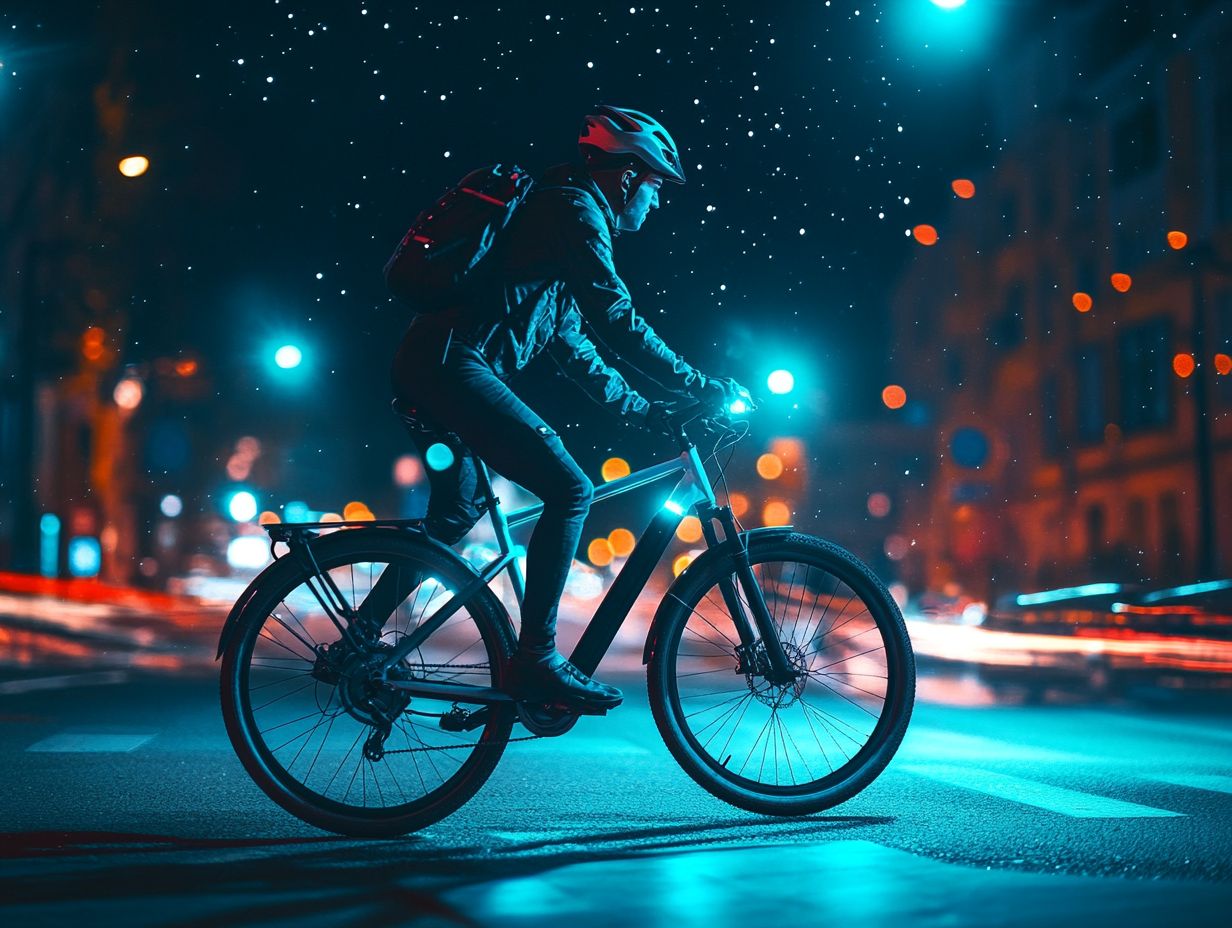
One of the primary advantages of riding electric bicycles at night is the unparalleled convenience they provide. Experience the thrill of zipping through traffic while enjoying an efficient mode of transportation.
By opting for e-bikes over traditional vehicles, you can reap significant cost savings. Electric bikes typically come with lower operational costs compared to gas-powered counterparts.
This efficiency not only translates into faster travel times but also into hassle-free parking. E-bikes require minimal space and can be secured in spots where cars would struggle to fit.
Unlike traditional transportation methods that often involve lengthy searches for parking or the burden of expensive garage fees, you can simply lock your e-bike nearby, often at no cost.
With reduced reliance on fuel, you ll see substantial savings. Say goodbye to those monthly gas expenses, the regular maintenance costs tied to combustion engines, and the financial strain of parking fees in urban areas. All these factors come together to make e-biking not just a convenient choice, but a remarkably financially savvy one as well.
Alternatives to Riding Electric Bicycles at Night
While electric bicycles offer a wealth of benefits, you may also want to explore alternatives for nighttime transportation that present different levels of safety and convenience.
Options like conventional bicycles, public transit, or rideshare services can be excellent alternatives, tailored to local regulations and your personal preferences.
Other Modes of Transportation
When you’re exploring alternatives to electric bicycles for nighttime travel, options like public transit and rideshare services can offer safe and efficient transportation.
Each choice presents its own advantages, from the accessibility of buses and trains to the convenience of rideshare apps that effortlessly connect you with drivers.
For example, public transit typically boasts set prices that don’t change, making it an economical option for longer journeys.
However, be mindful that schedules may be less frequent during late hours, which could lead to longer wait times.
Rideshare services provide an extra layer of convenience with their door-to-door service.
Safety, of course, becomes paramount at night; e-bikes can be risky due to limited visibility and the lack of dedicated bike lanes.
In contrast, both public transit and rideshare options generally emphasize passenger safety. Trained professionals and monitored environments are part of the package.
With safety at the forefront, these options shine as the smart choice for nighttime adventures!
Frequently Asked Questions
Can you legally ride electric bicycles at night?
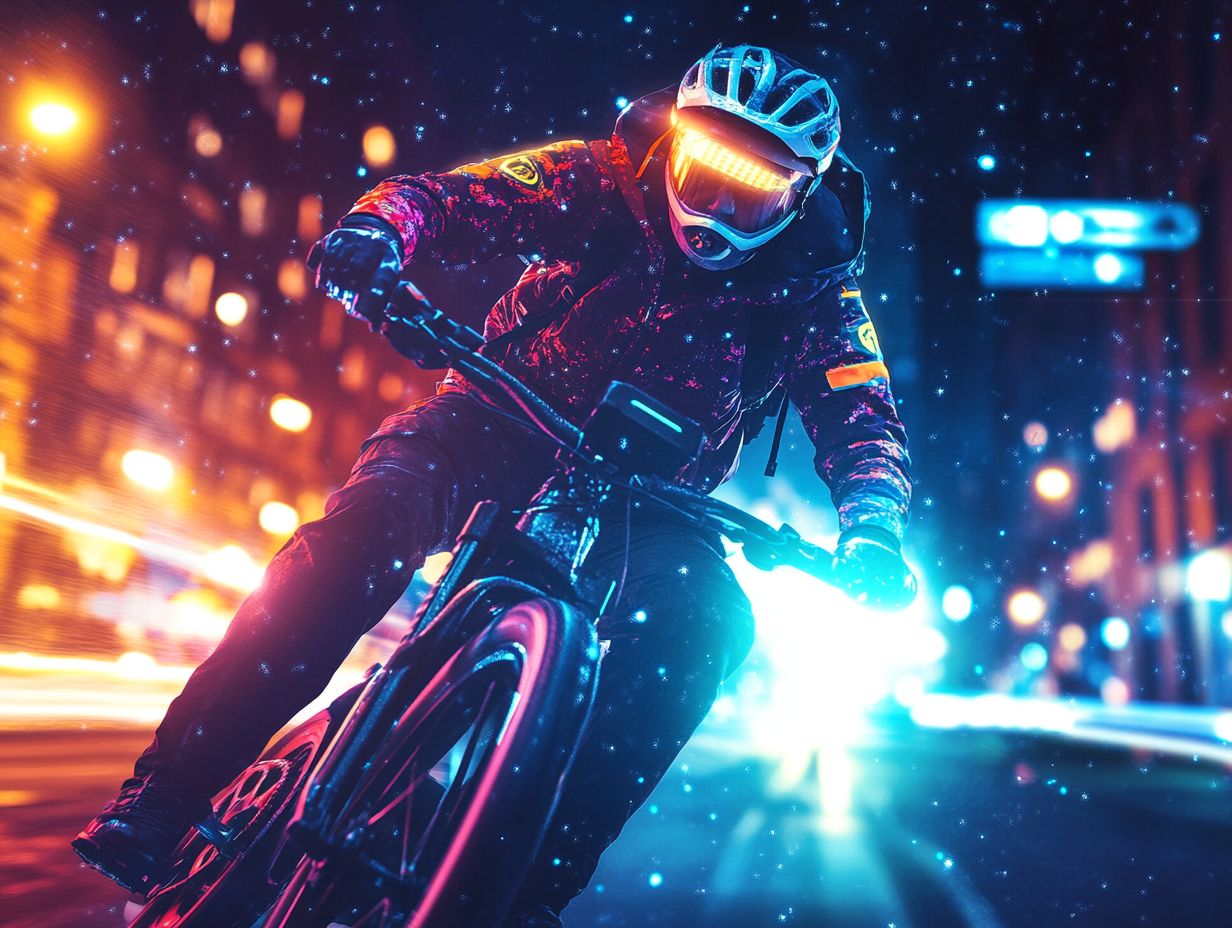
It depends on the laws and regulations in your specific location. Some places, such as California and New York City, may allow it, while others, like Florida and Alabama, may have restrictions.
What are the laws regarding riding electric bicycles at night?
Laws for riding electric bicycles at night vary by location. Generally, these bikes follow the same rules as traditional bicycles, which means safety equipment like lights and reflectors is a must.
Do I need any additional equipment to ride my electric bicycle at night?
Yes, electric bicycles require the same nighttime equipment as traditional bikes. This includes a white front light, a red rear light, and reflectors on the front, rear, and sides.
Are there speed restrictions for riding electric bicycles at night?
Speed limits for electric bicycles can differ by location. In some places, like Colorado and Washington, maximum speed limits may apply. Always check with local authorities for the latest regulations.
Can I get a DUI while riding an electric bicycle at night?
You can get a DUI (Driving Under the Influence) while riding an electric bicycle at night, just like on a traditional bike. Research the specific laws in your area, as penalties can vary widely.
Are there any safety tips for riding an electric bicycle at night?
Absolutely! Wear reflective clothing, use hand signals, and stay alert for hazards on the road. Keep your bicycle well-maintained for optimal safety, especially if you plan to ride off-road in places like National Parks.




